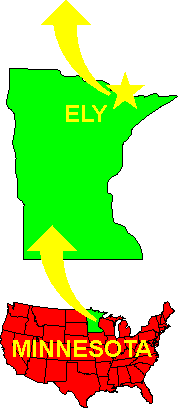About the Boundary Waters Canoe Wildernes Area (BWCA)


Northern Minnesota undoubtedly canoe country! If you enjoy some physical exertion and the special feeling of dipping your paddle into the lake to propel your canoe, then wilderness canoeing could be for you.
The combination of Minnesota's Boundary Waters Canoe Area (BWCA) and Ontario, Canada's Quetico Park form one of the world's great wilderness areas. It is the largest international area set aside for wilderness recreational purposes in the world. For thousands of years, this area has served as a travel corridor for native peoples and, most recently, as one of the primary routes to the west for European explorers and fur traders. The so-called Voyageurs' Highway runs through what is now the BWCA and Quetico Park. Today its tranquil waters and non-mechanized mode of travel serve as a special haven from the pressures of modern-day living.
Boundary Waters (BWCA)
The Boundary Waters Canoe Area Wilderness - protected as a true American wilderness and it has changed little since the glaciers melted. Canoeing, and fishing opportunities are almost endless on the more than 2,000 lakes and streams found within its forest. With 1,500 miles of canoe routes, almost 2,200 designated campsites, and more than 1,000 lakes and streams waiting, the BWCA boast some of the country's best fishing for walleye, northern pike, and smallmouth bass.
The Boundary Waters Canoe Area Wilderness (BWCA) is part of the National Wilderness Preservation System. It is managed by the United States Forest Service. NCCO, under contractual agreement as a "Cooperator", works with the Kawishiwi Ranger District, on the Superior National Forest. We also hold Guide/Packer Agreements, as well as Towboat / Van Agreements, with the U.S. Forest Service.
Quetico Provincial Park
Quetico Provincial Park, in Ontario, comprises the northern half of this international canoe country. At 1.2 million acres, Quetico Park is Ontario's second largest wilderness park. Routes here differ slightly from the U.S. side (not better and not worse). Portages and campsites are somewhat more rugged because the park does not have portage crews who manage the area as is done in the BWCA. With few exceptions, whatever can be found on one side of the border, can usually be found on the other: wildlife, fishing, and both isolated solitude as well as busy areas. The biggest difference is the nightly, per person, camping fee charges to visitors of Quetico Park.
More BWCA information
- Weather in the Boundary Waters Canoe Area
- The Ultimate in Eco-travel: Wilderness Canoe Trips
- Tips on BWCA Routes
- Tips on Entries to the BWCA
- Fishing in the BWCA
- Human History of the BWCA
- BWCA Wildlife & Plants
- BWCA Rules, Regulations & Fees
- Quetico Rules, Regulations & Fees
